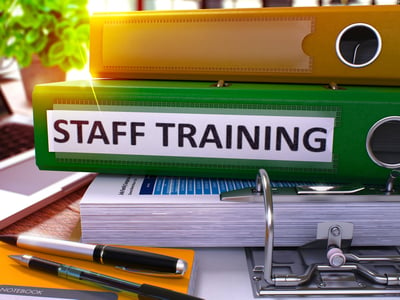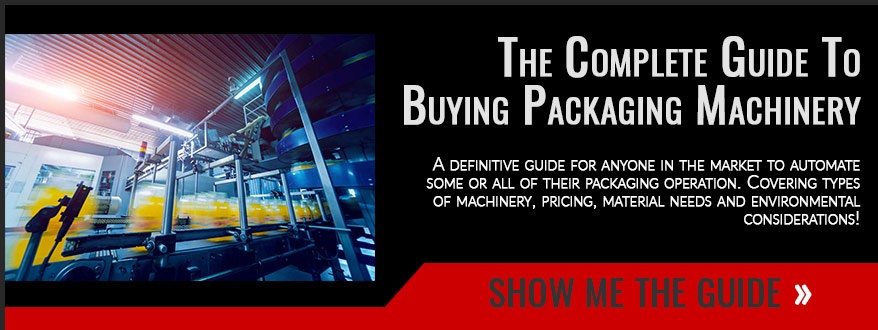Packaging Machinery Training For Sustainability And Success
If you have recently purchased any new packaging machinery, then you are or will be in the process of implementing a training program to ensure that your equipment operators are properly trained on your new machinery.
My guess is, you probably think about the necessity of this training for packaging machinery from one perspective: Safety. And while that is certainly one of the most important KPI's to track and consider when training your equipment operators, it is most certainly not the only important element of these training protocols.
While there are many reasons that you will want to procure quality training for packaging machinery, two important items are often overlooked: sustainability and overall success rates.
A lack of training or the implementation of poor training can lead not only to serious safety concerns but also wasted time, money, materials, and parts.
And, even if you do not suffer from these effects stemming from improper training, it is likely that the impact will result in slower production times, material and machinery issues, and other costly mistakes. All of which could have been avoided with the proper training in place.
Industrial Packaging has provided countless hours of quality training to thousands of companies and by extension, thousands of packaging machinery operators. As such, we can provide you with a deeper understanding of the true value within quality training protocols and applications.
In this article, we will be discussing the importance of high-quality training in relation to sustainability and a well-optimized, efficient, and quality packaging line.
Why Training On Packaging Machinery Is More Than Just Safety
Safety is number one. Always has been, always will be. There is a reason that the number one KPI for packaging lines is safety. Ensuring that your employees are working in a safe environment with the lowest probability of risk or harm is always going to be the number one priority.
However, it is easy to fall into the trap of thinking that this is the only metric to pay attention to when looking for the appropriate training for your packaging machinery equipment operators. However, safety is only the beginning of the elements that should be closely monitored, recorded, and analyzed when implementing training protocols.

Quality training on your packaging equipment not only helps to protect your people, but it also ensures that they fully understand each and every quality of the machines that they are running. From power-up to shutdown, from materials to repairs, there are many other factors that can be affected by good training or the lack thereof.
So what exactly are the other elements of proper training for packaging machinery equipment operators?
First off, you have to understand that well-run machinery manned by a well-trained operator equates to a smooth running packaging line that is fast, efficient, and can be counted on to produce quality packages. Making sure that you have properly trained operators is the first step in preparing for success.
Need Help Choosing The Right Packaging Machinery?
Packaging Machinery Training For Success
When you have a packaging line, there can be many moving parts to the puzzle and each one of those parts must be working properly and optimized correctly. Both of which are important items of consideration for the proper training of the people who are running your machinery.
For example, let’s say that you have a packaging line with a sealer, shrink tunnel, conveyor system, form, fill and seal machine, case erector, and finally, in your warehouse, stretch wrapping machinery.
Each of these pieces of machinery is one piece of the complete puzzle that is your successful packaging line. If the equipment operators on each of these devices have not had thorough and quality training you run the risk of the following problems.
- Wasted Time - If an equipment operator is not properly trained on a packaging machine, they may take longer to complete tasks, complete a task with errors, and work slower than expected. This all translates to wasted time, which means, wasted dollars.
- Wasted Materials - When your machinery operators are not trained well, this will often lead to the improper installation of packaging material or the installation of the wrong packaging material. This can lead to excessive waste, poor packaging, and the need for re-doing tasks multiple times in order to get the material to work correctly.
- Wasted Money - If your packaging machinery operators are constantly having to make changes or adjustments, this will cost you money. If they are only able to achieve their goals through trial and error, they will cost you time, materials, and potential repairs and parts, as well.
- Mechanical Problems - Simple mistakes such as using the wrong materials or the wrong machinery settings can cause mechanical errors and breakage. This directly leads to costly repairs and downtime.
- Downtime - Having to remedy any of the issues above can lead to short or in some cases, extended periods of downtime that can set you back in both time and money.
- Unexpected Repair Costs - Using the wrong materials or machinery settings can result in minor to major mechanical issues, some of which may result in the need for service, repair, and replacement parts or materials. These items can be costly.
- Injury - Poor training on your packaging machinery can result in not only costly repair and machinery and materials issues, but, more importantly, far more costly workmen's compensation payout.
- Retraining - Subpar training for your packaging machinery operators will likely result in the need for them to be re-trained on their respective equipment. This always results in additional training costs and will lead to lost time.
- Rework - If your operators have poor training, their efforts may lead to poor quality packaging which may require the need for the work to be redone. This will result in costly time and financial losses.
The Environmental Impact Of Poor Training
An important but often ignored byproduct of poor packaging machinery training is the environmental impact that can result. If your operators are constantly running your machinery with the wrong materials or settings, this often leads to wasted packaging materials due to the implementation of excess materials.

Those wasted materials are usually compromised or contaminated from the packaging process and will ultimately lead to these materials ending up in a landfill.
Many packaging materials such as shrink film and stretch film are made of plastic, and, if they end up in a landfill, can take in excess of one thousand years to fully biodegrade.
How To Source Quality Packaging Machinery Training
Before buying packaging machinery, make sure to discuss the training protocols with your packaging machinery vendor. Make sure that the people who provide the training are in fact certified on the make and model of machinery that you are buying.
If you do not currently have a packaging machinery vendor, consider reaching out to one of our packaging experts. Sure, they will be able to help you not only purchase the right packaging machinery for your needs. But they will also be able to ensure that you get certified training professionals to do the training even if you do not ultimately choose us as your vendor.
About Nathan Dube
As the Digital Marketing Specialist at Industrial Packaging, I am honored to create content for such a phenomenal company and work with one of the greatest teams in the Packaging Industry. Whether creating a video, writing blog posts or generating other pieces of content and multimedia, I am always excited to help educate and inspire our prospects and clients to reach their highest potential in regards to their packaging processes and needs.




